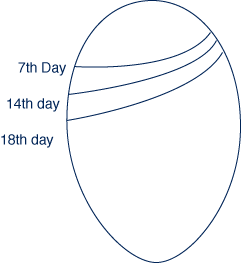Thought someone would like to read these.
General information on hatching. Very good, concise. Selection of stock and hatching info that covers it all in one site. From the University of Maine, Dr. Hawes and Dr. Opitz.
http://extension.umaine.edu/publications/2072e/
Egg selection and handling for hatching and hatching procedures
http://www.poultry.msstate.edu/extension/pdf/incubation.pdf
Trouble shooting hatching problems
http://msucares.com/poultry/reproductions/trouble.html
A jack pot of PDF and HTML files on anything poultry from North Carolina extension service. http://www.ces.ncsu.edu/depts/poulsci/tech_manuals/small_flock_resources.html
Uconn provides great detail of cleaning and set up for incubation. A little difficult to read, black on robin egg blue. Content is easy reading = designed for classroom use. At the end is a long list of egg sources.
http://sp.uconn.edu/~mdarre/4-hpoultry/helpfulhints.html
Porter isn't an official university, but he has plenty of experience with turkeys. Here's the info quoted from his site:
http://www.porterturkeys.com/egghatchingtips.htm
Diagrams of air cells, duck and chicken:
http://www.poultryconnection.com/quackers/aircell.html
How to set up a still air incubator. I found this as confusing to read as when I tried to set up a still air on my own. SOme of you may find it interesting to read. It is certainly more info than the manual that came with my still aair incubator. Try reading it after your morning cup of joe!
http://urbanext.illinois.edu/eggs/res19-opincubator.html
How to build a couple stryofoam still air incubators from Clemson university. Basic, with wiring design.
http://www.clemson.edu/psapublishing/Pages/ADVS/EC530.pdf
For those who have the LG, Little Giant incubator.
https://www.backyardchickens.com/web/viewblog.php?id=14596-incubation-cheat-sheet&PHPSESSID=6a9ef75252d048761e502795e39964f4
Pete55 has created a great thread on development and hatching including many very useful pics. Goose info is the basis w/chicken into also.
https://www.backyardchickens.com/t/491013/goose-incubation-hatching-guide-completed
Some of these sites will not be available as links change; this site will not allow me to edit out any further loss of links. Sorry for the inconvenience.
General information on hatching. Very good, concise. Selection of stock and hatching info that covers it all in one site. From the University of Maine, Dr. Hawes and Dr. Opitz.
http://extension.umaine.edu/publications/2072e/
Egg selection and handling for hatching and hatching procedures
http://www.poultry.msstate.edu/extension/pdf/incubation.pdf
Trouble shooting hatching problems
http://msucares.com/poultry/reproductions/trouble.html
A jack pot of PDF and HTML files on anything poultry from North Carolina extension service. http://www.ces.ncsu.edu/depts/poulsci/tech_manuals/small_flock_resources.html
Uconn provides great detail of cleaning and set up for incubation. A little difficult to read, black on robin egg blue. Content is easy reading = designed for classroom use. At the end is a long list of egg sources.
http://sp.uconn.edu/~mdarre/4-hpoultry/helpfulhints.html
Porter isn't an official university, but he has plenty of experience with turkeys. Here's the info quoted from his site:
http://www.porterturkeys.com/egghatchingtips.htm
Diagrams of air cells, duck and chicken:
http://www.poultryconnection.com/quackers/aircell.html
How to set up a still air incubator. I found this as confusing to read as when I tried to set up a still air on my own. SOme of you may find it interesting to read. It is certainly more info than the manual that came with my still aair incubator. Try reading it after your morning cup of joe!
http://urbanext.illinois.edu/eggs/res19-opincubator.html
How to build a couple stryofoam still air incubators from Clemson university. Basic, with wiring design.
http://www.clemson.edu/psapublishing/Pages/ADVS/EC530.pdf
For those who have the LG, Little Giant incubator.
https://www.backyardchickens.com/web/viewblog.php?id=14596-incubation-cheat-sheet&PHPSESSID=6a9ef75252d048761e502795e39964f4
Pete55 has created a great thread on development and hatching including many very useful pics. Goose info is the basis w/chicken into also.
https://www.backyardchickens.com/t/491013/goose-incubation-hatching-guide-completed
Some of these sites will not be available as links change; this site will not allow me to edit out any further loss of links. Sorry for the inconvenience.
Last edited:




